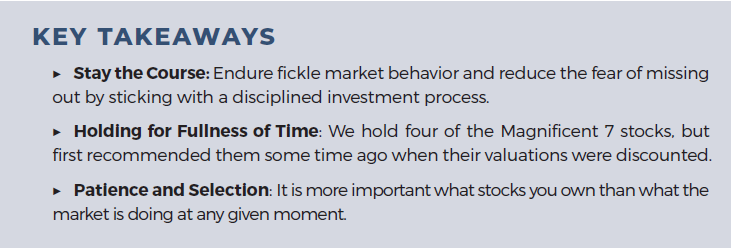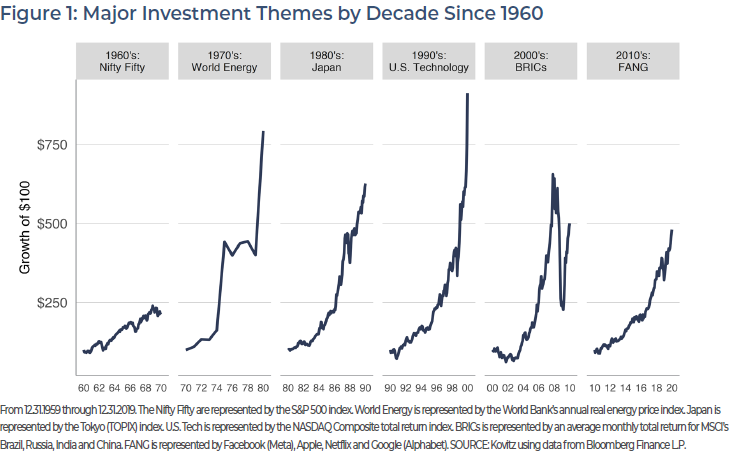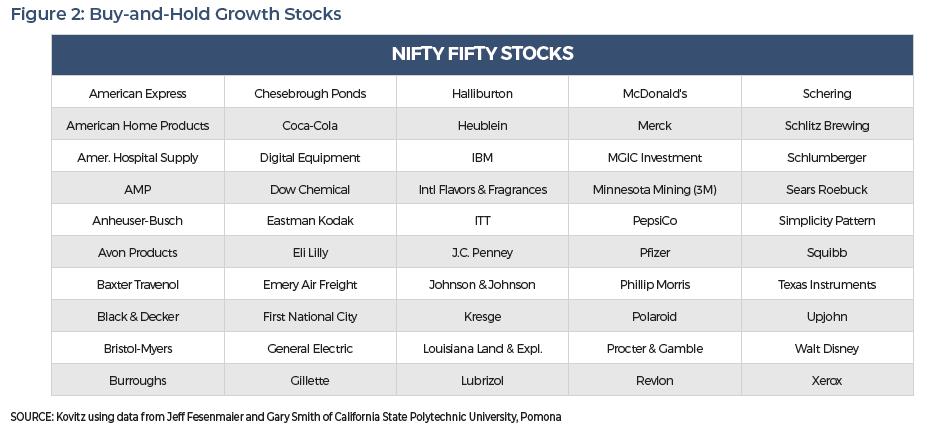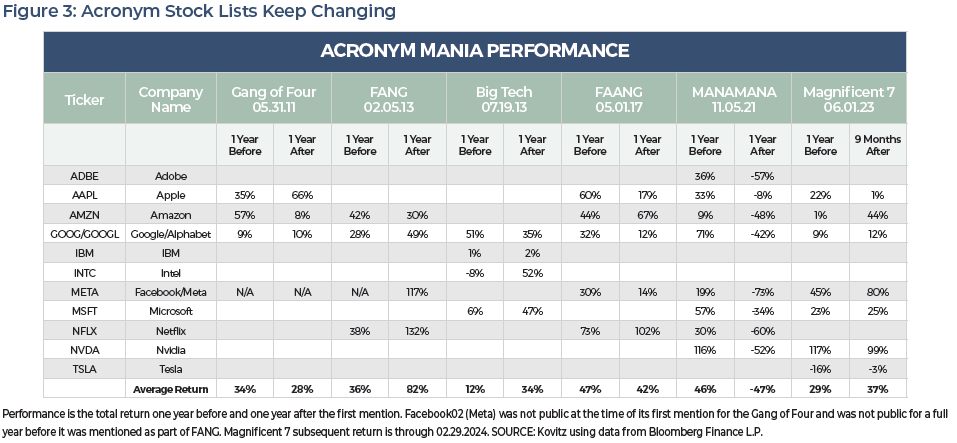
We can’t remember a day recently that skipped some mention of the “Magnificent 7,” a nickname for the seven stocks in the S&P 500 index that have swelled. By the end of February, nearly a third of the index by weight and half of the index’s 34% gain since October 2022 could be attributed to the septuplet of Apple (AAPL, 6.2% weight), Alphabet (GOOG, 3.5%), Amazon (3.8%), Meta Platforms (META, 2.5%), Microsoft (MSFT, 7.2%), Nvidia (4.6%) and Tesla (1.3%).
Hype on television and in print has projected a sense of missing out on investors who do not own the group of stocks. That should not be the case. As we’ll detail in this Insight, hot investment themes (and indeed acronyms) change. We own four of the Magnificent 7 in our portfolios, but not at the S&P’s weights, and we initially recommended them with inexpensive valuations.
In Figure 1, we chart performance by ‘theme’ for each decade (or so). In recent history, it’s fairly easy to access all of the areas of focus in the chart. However, it’s worth noting that some of these trends were hard to exploit in the past. With the benefit of hindsight, one could believe they’d have capitalized on the on-the-run mania, but how many individual investors had oil drums filled with crude to sell in the 1970’s?

The Nifty Fifty
Through the 1960’s and into the early 1970’s, investors were enamored with the “Nifty Fifty” stocks, a collection of 50 NYSE-listed Growth stocks (listed in Figure 2) that were considered to be ‘one-decision’ investments, meaning the only choice you as an investor had to make was to buy them. A check of fundamentals, a cursory overview of a business model or any other investigation was simply not necessary. Investors of all types piled into to the group of large-cap stocks, encouraged by widespread enthusiasm, earnings growth and healthy dividend yields since the Second World War. Share prices soared, and valuations became very expensive relative to both market history at the time and in present day.
The bubble burst between January 11, 1973 and October 3, 1974 and the price of the broad S&P 500 index (which included the Nifty Fifty stocks) fell right back to Earth, -48.20% to be exact. Interestingly, a sudden lack of interest in expensive valuations and high-flying stocks did not trigger the implosion. Instead, the Bear Market was caused by the oil crisis of 1973-1974, while there were other geopolitical and macroeconomic factors in play at the time that exacerbated the decline.
Wharton Professor Jeremy Siegel wrote a follow-up on the Nifty Fifty in the AAII (American Association of Individual Investors) Journal in October 1998, explaining, “A portfolio of Nifty Fifty stocks purchased at the peak would have nearly matched the S&P 500 over the next 26 years. Wall Street’s misunderstanding led to a dramatic undervaluation of many of the large growth stocks throughout the 1980’s and early 1990’s. Stocks with steady growth records are worth 30, 40, and sometimes more times earnings.”
Dr. Siegel concluded that there were three lessons to be learned from the episode. First, investors must pay for growth. Second, investors must not pay any price for growth. He explained, “Among these growth stocks, those with the lower price-earnings ratios tended to outperform those with higher price-earnings ratios over time.” Third, investors must remain diversified. While it’s enticing to buy recent top performers, diversification is critical to managing risk and maintaining returns.
Of course, a lot has happened since 1998 and data simply does not exist (in the public domain, anyway) to update much of Dr. Siegel’s analysis with more recent figures. Of the original Nifty Fifty bunch, our broadly diversified portfolios have exposure to the likes of Bristol-Myers Squibb (BMY), Walt Disney (DIS), Int’l Business Machines (IBM), Johnson & Johnson (JNJ), Minnesota Mining & Manufacturing (MMM), Merck & Co (MRK) and Pfizer (PFE). Of course, with an inception date of only March 1977, The Prudent Speculator founder Al Frank arrived too late for his track record to begin amidst the euphoria–or carnage–earlier in the decade. There are certainly lessons to be learned from the rise and fall of the Nifty Fifty, and we think Dr. Siegel’s take-home points from 1998 remain highly relevant in today’s investing environment.

Energy Crises Galore
Geopolitical events spilled into the oil markets in the 1970’s, causing euphoria for some and pain for others. The Arab-Israeli conflict resulted in the closing of the Suez Canal, a major shipping lane, for eight years between 1967 and 1975. Concurrently, Venezuela and the United States each had their oil production peak in 1970, while Iran’s production levels reached its maximum in 1974. America was forced to fix domestic supply constraints with imported oil, even as global politics caused many challenges getting the black stuff delivered. Shortages persisted, initially for heating oil and eventually in all types of oil-based substances, and prices soared.
Oil was the place to invest in the 1970’s, as Figure 1 on the first page shows. However, at the time, there were few vehicles other than the major oil companies that one could use as proxies to invest with the trend. Data from StatMuse shows oil-producer British Petroleum returned 320% and Chevron (CVX) returned 228% in the 1970’s. Certainly, we would not complain about either of the returns, but they are nowhere near the 692% return for energy prices that Figure 1 would imply an investor would have earned if they invested in the decade’s hot theme.
Across the Pacific
The 1980’s saw the rise of Japanese stocks. In the first half of the decade, Japan’s TOPIX (Tokyo) index doubled thanks to very loose monetary policy by Japan’s central bank, which caught the attention of investors worldwide. They piled in. The index rose another 216% before the end of the decade, peaking on December 18, 1989. The index fell 62% before bottoming in August 1992 and academic investigation of the events has largely attributed the collapse to the Bank of Japan’s delayed action to reign in asset prices. The damage was far and wide, reaching beyond the equity markets into real estate, bonds and the Japanese economy. As with energy investing in the 1970’s, it would have been difficult and expensive for a U.S. investor to buy Japanese assets in comparison to today’s investment options, including ETFs and direct global market access.
The Dot-Com Era
Al Frank, founder and Editor of The Prudent Speculator until he passed away in 2002, and John Buckingham were hard at work in the 1990’s, buying dollar bills for fifty cents and publishing the newsletter with real-time commentary (for those that have interest, The Prudent Speculator’s website has all editions of the newsletter in Adobe PDF format available for perusing). Access to the World Wide Web via a browser called ‘Mosaic’ in January 1993 gave personal computer users the first taste of a connected world and potential use cases for the technology were immediately clear. Of course, connecting to the internet was difficult and often dropped out or didn’t work, but that did not dissuade companies from rushing to capitalize on the revolution.
Companies cropped up overnight and investors shoved enormous amounts of capital their way. Profitability was no impediment, nor were there many other considerations for that matter. Simply being associated with technology, the internet or computing was enough to send a share price soaring. And soar they did. The aggregate NASDAQ Composite index rose more than 800% in the 1990’s, and the top 100 stocks in the index rose twice that amount. Those gains, while large, are weak in comparison to the decade’s biggest winners. Dell Computer gained 91,863% between December 31, 1989 and December 28, 1999. EMC, an enterprise storage maker, gained 74,577%, while electronics manufacturing outfit Solectron and telecommunications solutions provider Telllabs rose 19,751% and 17,084%, respectively.
The New York Times wrote just before the new millennium, “The hottest stocks of the 1990’s are virtually an all-tech affair, as a list of the top performers compiled for The Times by Ned Davis Research shows… Just look at Dell Computer Corp… a $5,000 investment in the personal computer maker at the start of the ‘90s would be worth more than $4.5 million today. You could have become a Dell millionaire by putting in only about a grand.”
It all came undone in March 2000. The NASDAQ Composite index fell 78% between March 10, 2000 and October 9, 2002. The NASDAQ Top 100 stocks index fell 82% over that time, while the broad-based S&P 500 index fell 42% including dividends. Any investor that invested in the NASDAQ Top 100 index after December 31, 1996 would have been back to square one by October 9, 2002. It was a remarkable boom and bust cycle.
Departing the States
Investors were licking their wounds following the bursting of the Tech Bubble, and those who had not been wiped out turned their attention to the BRICs countries of Brazil, Russia, India and China. A Goldman Sachs research report in November 2001 officially coined the term and money was on the move. The attractiveness of the BRICs stocks was spelled out in the first key point of the report: In 2001 and 2002, real GDP growth in large emerging market economies will exceed that of the G7. With that, the dash was on and in 2007, iShares launched the FTSE BRIC 50 index, giving investors easy access to the exposures. The shifts to exposures outside the U.S. worked, with the average return between the four countries coming in at 400% in the first decade of the new millennium, compared to a -9% total return for the S&P 500 index. Winds shift quickly, and investors that overstayed the trend would have experienced dismal returns from China and a wipeout for most Russian positions.
Gang of Four, Big Tech, FAANG, et al.
In 2011, Google chairman Eric Schmidt said he believed there’s a new “Gang of Four” companies growing at tremendous rates: Google (now Alphabet), Apple, Amazon and Facebook (Meta Platforms). Interestingly, Mr. Schmidt said fifth and sixth places likely belong to PayPal and Twitter. Microsoft, he said, “is not driving the consumer revolution.”
“Big Tech” was used for the first time by The Wall Street Journal in July 2013 in an article titled “Big Tech: Too Big for Its Own Good” that lamented the bad earnings season for the likes of Google (Alphabet), IBM, Microsoft and Intel (INTC). Rolfe Winkler wrote, “They may be in different businesses but, with one big exception [Google], all are stalling for similar reasons: They have gotten too big, and their primary products are either too old or poorly engineered for new, fast-expanding markets.” The article concluded, “What new technologies will do is keep a lid on growth opportunities. Except, that is, for Google, where new technology remains an opportunity.”
At the same time, CNBC anchor and host of Mad Money, Jim Cramer, used the acronym ‘FANG’ in an article published in 2013, which stood for a different set of tech stars, including Facebook, Amazon, Netflix and Google. CNBC has morphed Mr. Cramer’s acronym further. Apple was added in 2017 to create FAANG and in 2021 The Motley Fool ran an article with MANAMANA for Microsoft, Apple, Netflix, Alphabet, Meta, Amazon, Nvidia, and Adobe. The Magnificent 7 is Mr. Cramer’s latest hot pick list, a group of companies that he believes will benefit from generative A.I.
In Figure 3, we present the very-fluid membership of recent “acronym” stocks and their one year returns before and after the first usage of the acronym. While many of the acronyms have succeeded in gaining high subsequent returns, the figure shows a considerable upside is available to investors prior to a wave of investor interest (or in many cases, a Cramer mention).

The Problem
There’s nothing wrong with certain stocks getting their day in the sun (even if we do not own them in our broadly diversified portfolios). The attention that has been drawn to the FAANG stocks, the Magnificent 7 or any other grouping is almost always well-deserved, and we are happy to own many of them for our clients. However, the point of walking through decades of market history in this Investment Insight is to show that trends can change quickly and thematic investing often is a backward-looking retelling, rather than a forward-looking endeavor.
And to be fair, holding the Acronym stocks through thick and thin would easier have been said than done. Since Mr. Cramer’s first use of FANG, the group’s members have seen some sizable drops. Facebook (Meta Platforms) fell 77% between September 7, 2021 and November 4, 2022, while Amazon fell 56% between July 8, 2021 and December 28, 2022 and Netflix tumbled 76% between November 17, 2021 and May 11, 2022. Google’s (Alphabet) decline was comparatively shallow at -44% between November 18, 2021 and November 3, 2022. Despite the interceding drops, the long-term gains have been large, although data from DALBAR supports the idea that few likely had the discipline to keep the faith when market forces were conspiring against them.
The market ebbs and flows, and fortunately it has done more rising than falling since March 1977. Our experience is that the biggest opportunities come when others are heading for the exits, rather than when everyone is jamming towards the entrance. For example, when the Tech Bubble burst in 2000, we added 97 stocks to our Recommended List. We still hold two of them. Whirlpool was first recommended on August 31, 2000 at $38.02, while Apple Computer (yes, the Apple) was first recommended at a split-adjusted $0.40 on October 6, 2000. Apple even declined another 37% in the two months after we bought it! For the other 95, we held them an average of 6.6 years with a mean annualized return of 11.3%. For transparency, we have always offered our complete historical recommended list in the footer of our website or via this link.
Of course, many of the Nifty Fifty still exist, the FANG stocks on balance have thrived and the Magnificent 7 have done well in a short period of time. Showing up late to the party remains a risk, as subsequent MANAMANA performance shows, and we hope investing short-cuts like acronyms do little to dissuade those who do their homework from sticking with reasonably priced stocks even if a collection of stocks goes crazy.
Don’t Head for the Exits
The problem is that there are always reasons to bail on stocks. We see them. We read them. We hear them. The worries usually sound very intelligent, and therefore are remarkably effective in getting folks to jump off the path to success. After all, the business model of the media is to keep you coming back. That’s not a complaint and a free press serves a vital function, but knowing it’s the case should make it easier to disconnect long-term investment actions from short-term noise. Recently, we’ve heard worries that the S&P 500 index’s multiple is too high, the weight in the top U.S. stocks is too heavy, artificial intelligence is going to be the end of human workers and stocks have risen too fast. There’s an underlying factual element in each of those concerns, and that makes the emotional alarms more intense, even as important context is lacking.
Al Frank wrote in The Prudent Speculator edition #52 in February 1979, “Assuming one could anticipate market turns with some precision, it is not clear that getting in and getting out with every reversal would be a winning strategy. The cost of commissions [as well as bid-ask spreads and capital gains taxes] could be prohibitive, the reversals too quick and shallow for anything but balancing gains against losses and from time to time a miscalculation or anomaly could provide a serious setback. Meanwhile, the relationship between any given stock and a market reversal is a whole ‘nother story. But one could be ignorant of anticipating market reversals, yet do quite well as he applies his modest knowledge of long-term probabilities for individual stocks and the companies they represent.”
Over the decades, the names in our portfolios have changed and we have evolved our approach to include the latest tools, best practices and resources (thank goodness we do not have to do portfolio accounting by hand anymore!), while our philosophy has remained constant throughout. We believe the steady approach has served us well. We’ll turn this over to Al from 1991 to wrap up, “With patience, consistency and some intelligent portfolio management, I believe that it is more important what stocks you own than what the market is doing at any given moment… Next time some pithy advice sounds wise, try to find its obvious or subtle logic or lack of same before accepting it at face value and trying to operationalize its guidelines.”
Partner with Us
Through our partnership with Kovitz, our team collaborates to make your wealth work for you. We are committed to ensuring that your comprehensive financial strategy is thoughtful, personalized and effective. For more details about our wealth management and asset management services, kindly reach out to Jason R. Clark, CFA at 949.424.1013 or jclark@kovitz.com.
TPS Investment Insights - Trendy Investing: The Magnificent 7 Stocks

